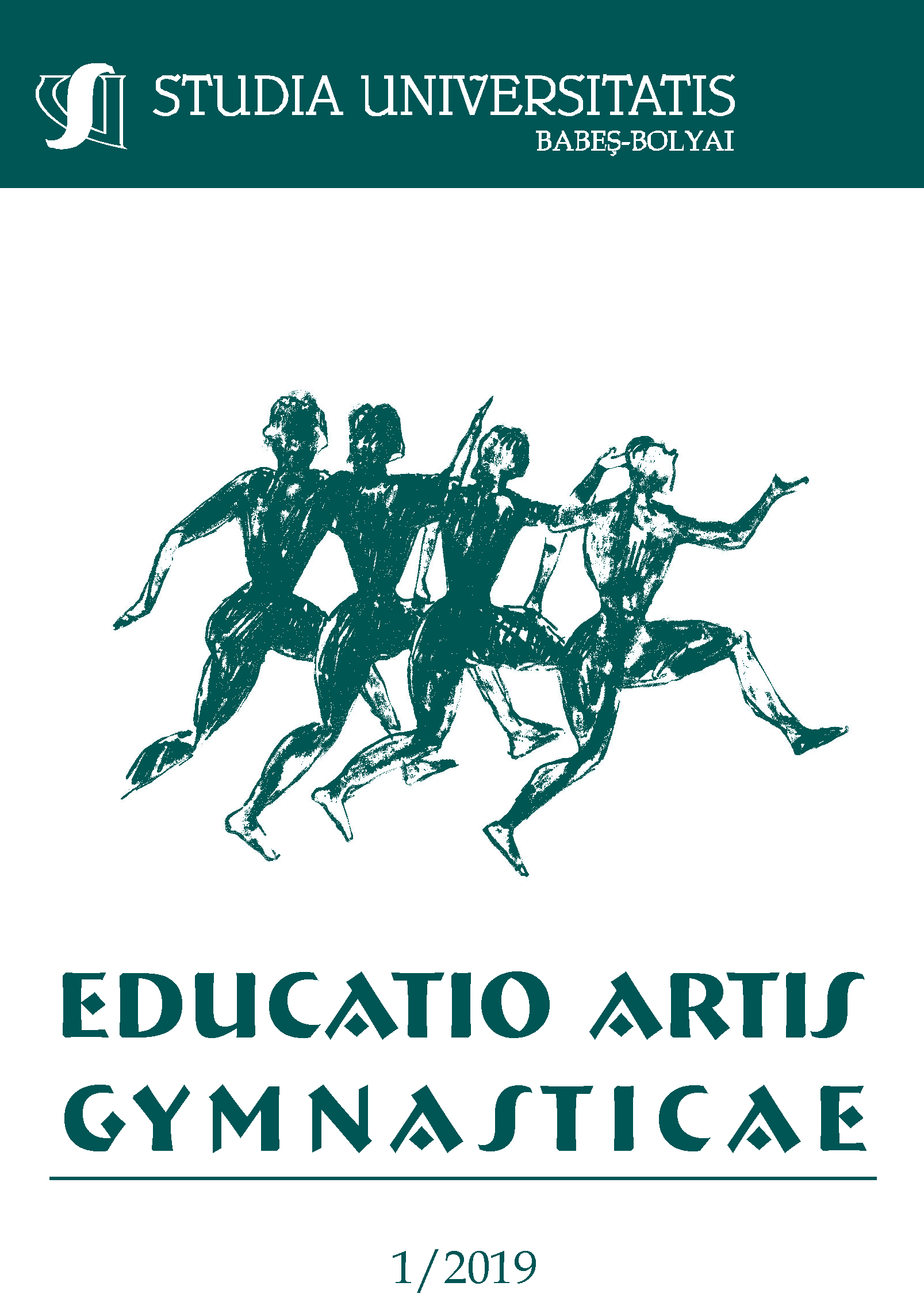DIFFERENCES IN PSYCHOLOGICAL CHARACTERISTICS OF ELITE JUNIOR HANDBALL PLAYERS
DOI:
https://doi.org/10.24193/subbeag.64(1).01Keywords:
handball, posts, BFQ, psychological characteristics.Abstract
The aim of the present paper is to investigate personality traits among junior handball players in different player positions and examine whether a standard can be established as to what personality traits the players in the individual positions should have. A Big Five Questionnaire survey was conducted in the early training period of 2016-2017 among elite Hungarian junior handball players (n=164, in terms of posts of playing players 25% were backcourt players, 23.2% wingers and 18.9% playmakers.). Big Five personality traits: Extroversion, Agreeableness, Conscientiousness, Neuroticism and Openness. Neuroticism showed significant differences by gender (t=3.9 p<0.001), where males reached significantly higher scores (Mmale=65.7, Mfemale=53.1). 16, 17 and 18 year-old players reported higher levels in each personality trait than 14-15 year olds (p<0.001). Playing posts did not indicate any significant differences. All personality traits showed significant and strong interrelations. Only Neuroticism resulted in significant interaction of gender and age (p<.05). The results of investigating personality profile characteristics by gender, age and posts have revealed crucial factors of handball players. It is important to underline that a sport psychological approach, dealing with personality profiles, has significant benefits in the development of players, particularly adolescent players.References
Alexandru, M.A., Ruxandra R., Carmenb, G.G. (2014). Predictors of tennis performance of junior players. Procedia - Social and Behavioral Sciences, 116. 5169 – 5174.
Bebetsos, E., Bebetsos, G. (2006). Greek Youth Team Handball Players and Their Satisfaction Levels. European Handball Magazine, p. 1-9.
Boiché, J.C.S., Sarrazin, P.G. (2007). Self-determination of contextual motivation, inter-context dynamics and adolescents’ patterns of sport participation over time. Psychology of Sport and Exercise, 8. 685–703.
Bjørndal, C.T., Ronglan, L.T. (2017). Orchestrating talent development: youth players’ developmental experiences in Scandinavian team sports. Sports Coaching Review, 7 (1), p. 1-22.
Caprara, G.V., Barbaranelli, C., Borgogni, L., Perugini, M. (1993). The „Big Five Questionnaire”: A new questionnaire to asses the five factor model. Personality and Individual Differences, 15 (3), 281-288.
Casimiro, E., Lázaro, J.P., Fernandes, H.M., Vasconcelos-Raposo, J. (2010). Determination of Portuguese Handball Player Performance Psychological Profile. EHF Web Periodical http://home.eurohandball.com/ehf_files/Publikation/WP_Casimiro%20et%20al_Psych%20Profile_080822e.pdf, Retrieved: 2015.10.23.
Côté J, Bruner MW, Erickson K, Strachan L, Fraser-Thomas J. (2010): Athlete development and coaching. In: Lyle, J., Cushion, C.: Sport coaching: Professionalization and practice. Oxford, UK: Elsevier, pp. 63–83.
Eklund, R.C., Tenenbaum, G. (2014). Encyclopedia of Sport and Exercise Psychology. SAGE Publications, Los Angeles, London, New Delhi, Singapore, Washington DC.
Gonzalez. S.P.I., Coronado, J.F.O. (2011). Competitive Anxiety and Stress in Young Handball Players. EHF Scientific Conference, Austria, p. 54-57.
Gonzalez. S.P.I., Coronado, J.F.O. (2011). Psychological characteristics of young handball players and its importance for handball coaches. EHF Scientific Conference, Austria, p. 58-62.
Gyömbér, N., Kovács, K., Ruzits, É. (2016). Fejben dől el. Sportpszichológia mindenkinek. Budapest: Noran Libro Publisher.
Holland, M.J.G., Woodcock, C., Cumming, J., Duda, J.L. (2010). Mental Qualities and Employed Mental Techniques. Journal of Clinical Sport Psychology, 4, 19-38.
Ivanović, M., Milosavljević S., Ivanović, U. (2015). Perfectionism, anxiety in sport, and sport achievement in adolescence. Sport Science, 8, 1: 35‐42.
Kais, K., Raudsepp, L. (2005). Intensity and direction of competitive state anxiety, self-confidence and athletic performance. Kinesiology. 37(1): 13-20.
Marczinka, Z.: What’s the Difference? – Coaching Female and Male Handball Players. EHF Scientific Conference, Austria, p. 89-93.
Mayer W.F. (2001). An investigation of cognitive-affective stress management training with golfers. PhD Dissertation. Alliant International University, San Diego.
Milavić, B., Grgantov, Z., Milić M. (2013). Relations between coping skills and situational efficacy in young female volleyball players. Facta Universitatis, Series: Physical Education and Sport Vol. 11, N pp. 165 – 175.
Mouratidis, A., Michou, A. (2011). Perfectionism, self-determined motivation, and coping among adolescent athletes. Psychology of Sport and Exercise, 12. 355-367.
Olmedilla, A., Ortega, E., Gercés de los Fayos, E., Abenza, L., Blas, A. y Laguna, M. (2015). Perfil psicolőgico de los jugadores profesionales de balonmano y differencias entre puestos específicos. Revista Latinoamericana de Psicología 47, 177-184.
Pandey, A., Patel, R.K. (2015). Comparison and assessment of mental health among different playing positions in handball. International Journal of Applied Research, 1(13): 182-185.
Piaget, J., Inhelder, B. (2004). Gyermeklélektan. Budapest: Osiris Kiadó.
Pollany, W. (2007). Match results are all in the head. A multidimensional analysis of two final games. EHF, Handball, p. 46-55.
Rogulj, N., Srhoj, V., Nazor, M., Srhoj, L. and Cavala, M. (2005). Some Anthropologic Characteristics of Elite Female Handball Players at Different Playing Positions. Collegium Antropologicum 29. 2: 705-709.
Seznec, J.C., Lépine, J.P., Pélissolo, A. (2003). Dimensional personality assessment of the members of the French junior national team of road cycling L’Encéphale, XXIX: 29-33.
Shariati, M., Bakhtiari, S. (2011). Comparison of personality characteristics athlete and non-athlete. Procedia - Social and Behavioral Sciences, 30. 2312-2315.
Srhoj, V., Marinovic, M. and Rogulj, N. (2002). Position Specific Morphological Characteristics of Top-Level Male Handball Players. Collegium Antropologicum, 26. 1: 219-227.
Stewart, C., Meyers, M.C. (2004): Motivational Traits of elite young soccer players. Physical Educator, v61, n4, p213-218.
Velickovska, L.A., Damovska, Anastasovski, A., Koteva-Mojsovska, T. (2014): Anxiety among athletes-basketball player and nonathletes during the medium adolescence. Research in Physical Education, Sport and Health, Vol. 3, No. 1, pp. 63-65.
Wylleman, P., Alfermann, D., Lavalee, D. (2004). Career transitions in sport: European perspectives. Psychology of Sport and Exercise, 5. 7–20.
Zimbardo, P.G., Johnson, R.L., McCann, V. (2017). Psychology: Core concepts, books a la carte. 8th Edition, Pearson Education, Copyright.
Downloads
Published
How to Cite
Issue
Section
License
Copyright (c) 2019 Studia Universitatis Babeș-Bolyai Educatio Artis Gymnasticae

This work is licensed under a Creative Commons Attribution-NonCommercial-NoDerivatives 4.0 International License.



